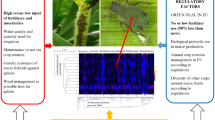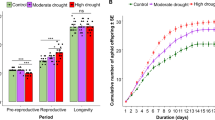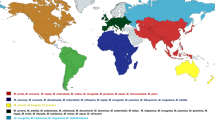Abstract
Spider mites are some of the most important agricultural pests worldwide, jeopardizing maize production across many continents. However, mechanisms of resistance to spider mite in maize remain unclear. Here, we report data from resistant and susceptible maize varieties, **gke968 and **anyu335 along with their parental lines, and investigate their responses to Tetranychus urticae (Acari: Tetranychidae). A significantly lower female adult mite population and total mite numbers were recorded in the resistant variety, **gke968, compared to **anyu335. Similarly, mite fecundity on **gke968 was substantially lower compared to **anyu335, which could be associated with its highly resistant parental line **g92. Stomatal dimensions also showed a close correlation with the fitness of spider mites on the two maize varieties and four parental lines. Tetranychus urticae population numbers under field conditions showed lower mite densities (numbers per plant) in **gke968 and **g92 (75% and 89% lower, respectively) than the most sensitive line PH6WC, hinting toward a high level of resistance to spider mites in these maize lines. Our study provides new insights for mechanisms of physical defense to spider mites in maize and contributed to the basis for pest control and breeding of maize varieties.



Similar content being viewed by others
Availability of data and materials
All data are available in the manuscript, and materials are available upon requests.
References
Agrawal AA (1998) Induced responses to herbivory and increased plant performance. Science 279(5354):1201–1202. https://doi.org/10.1126/science.279.5354.1201
Archer T, Peairs F, Mihm J (1997) Mechanisms and bases of resistance in maize to mites. In: Insect resistant maize: recent advances and utilization. Proceedings of an international symposium held at the International Maize and Wheat Improvement Center
Atkinson JA, Wells DM (2017) An updated protocol for high throughput plant tissue sectioning. Front Plant Sci 8:1721. https://doi.org/10.3389/fpls.2017.01721
Beran F, Petschenka G (2022) Sequestration of plant defense compounds by insects: from mechanisms to insect–plant coevolution. Annu Rev Entomol 67:163–180. https://doi.org/10.1146/annurev-ento-062821-062319
Bernal JS, Dávila-Flores AM, Medina RF, Chen YH, Harrison KE, Berrier KA (2019) Did maize domestication and early spread mediate the population genetics of corn leafhopper? Insect Sci 26(3):569–586. https://doi.org/10.1111/1744-7917.12555
Betz FS, Hammond BG, Fuchs RL (2000) Safety and advantages of Bacillus thuringiensis-protected plants to control insect pests. Regul Toxicol Pharmacol 32(2):156–173. https://doi.org/10.1006/rtph.2000.1426
Bui H, Greenhalgh R, Ruckert A, Gill GS, Lee S, Ramirez RA, Clark RM (2018) Generalist and specialist mite herbivores induce similar defense responses in maize and barley but differ in susceptibility to benzoxazinoids. Front Plant Sci 9:1222. https://doi.org/10.3389/fpls.2018.01222
Bui H, Greenhalgh R, Gill GS, Ji M, Kurlovs AH, Ronnow C, Lee S, Ramirez RA, Clark RM (2021) Maize inbred line B96 is the source of large-effect loci for resistance to generalist but not specialist spider mites. Front Plant Sci 12:693088. https://doi.org/10.3389/fpls.2021.693088
Calderon-Vazquez C, Ibarra-Laclette E, Caballero-Perez J, Herrera-Estrella L (2008) Transcript profiling of Zea mays roots reveals gene responses to phosphate deficiency at the plant-and species-specific levels. J Exp Bot 59(9):2479–2497. https://doi.org/10.1093/jxb/ern115
Carmona D, Lajeunesse MJ, Johnson MT (2011) Plant traits that predict resistance to herbivores. Funct Ecol 25(2):358–367. https://doi.org/10.1111/j.1365-2435.2010.01794.x
Chen YH, Gols R, Benrey B (2015) Crop domestication and its impact on naturally selected trophic interactions. Annu Rev Entomol 60:35–58. https://doi.org/10.1146/annurev-ento-010814-020601
Chen C, Liu X, Li S, Liu C, Zhang Y, Luo L, Miao L, Yang W, **ao Z, Zhong Y, Li J, Chen R, Chen S (2022a) Co-expression of transcription factors ZmC1 and ZmR2 establishes an efficient and accurate haploid embryo identification system in maize. Plant J 111(5):1296–1307. https://doi.org/10.1111/tpj.15888
Chen Y, Wang S, Zhao J, Ren W, Shi Z, Di N, ** D (2022b) Effects of leaf physical characters of maize hybrid **gke 968 on the resistance to Tetranychus urticae Koch (Acari: Tetranychidae). J Environ Entomol 44(01):229–235. https://doi.org/10.3969/j.issn.1674-0858.2022.01.26
de Lillo E, Freitas-Astúa J, Kitajima E, Ramos-González P, Simoni S, Tassi A, Valenzano D (2021) Phytophagous mites transmitting plant viruses: update and perspectives. Entomol Gen 41:439–462. https://doi.org/10.1127/entomologia/2021/1283
Dermauw W, Wybouw N, Rombauts S, Menten B, Vontas J, Grbic M, Clark RM, Feyereisen R, Van Leeuwen T (2013) A link between host plant adaptation and pesticide resistance in the polyphagous spider mite Tetranychus urticae. Proc Natl Acad Sci USA 110(2):E113-122. https://doi.org/10.1073/pnas.1213214110
Desneux N, Decourtye A, Delpuech JM (2007) The sublethal effects of pesticides on beneficial arthropods. Annu Rev Entomol 52:81–106. https://doi.org/10.1146/annurev.ento.52.110405.091440
Dutton A, Obrist L, D’Alessandro M, Diener L, Muller M, Romeis J, Bigler F (2004) Tracking Bt-toxin in transgenic maize to assess the risks on non-target arthropods. IOBC WPRS Bull 27(3):57–63. https://eurekamag.com/research/004/370/004370290.php
Duvick DN (2005) The contribution of breeding to yield advances in maize (Zea mays L.). Adv Agron 86:83–145. https://doi.org/10.1016/S0065-2113(05)86002-X
Gao L, Gonda I, Sun H, Ma Q, Bao K, Tieman DM, Burzynski-Chang EA, Fish TL, Stromberg KA, Sacks GL, Thannhauser TW, Foolad MR, Diez MJ, Blanca J, Canizares J, Xu Y, van der Knaap E, Huang S, Klee HJ, Giovannoni JJ, Fei Z (2019) The tomato pan-genome uncovers new genes and a rare allele regulating fruit flavor. Nat Genet 51(6):1044–1051. https://doi.org/10.1038/s41588-019-0410-2
Gill GS, Bui H, Clark RM, Ramirez RA (2022) Spider mite resistant maize lines, B75 and B96, maintain resistance under water-stress. J Pest Sci 96(3):1117–1132. https://doi.org/10.1007/s10340-022-01584-3
Glas JJ, Schimmel BC, Alba JM, Escobar-Bravo R, Schuurink RC, Kant MR (2012) Plant glandular trichomes as targets for breeding or engineering of resistance to herbivores. Int J Mol Sci 13(12):17077–17103. https://doi.org/10.3390/ijms131217077
Guo F, Zhang Z-Q, Zhao Z (1998) Pesticide resistance of Tetranychus cinnabarinus (Acari: Tetranychidae) in China: a review. Syst Appl Acarol 3(1):3–7. https://doi.org/10.11158/saa.3.1.1
Guo Y-L, Jiao X-D, Xu J-J, Yang S, Duan X-K, Zhang J-P (2013) Growth and reproduction of Tetranychus turkestani and Tetranychus truncatus (Acari: Tetranychidae) on cotton and corn. Syst Appl Acarol 18(1):89–98. https://doi.org/10.11158/saa.18.1.10
Jactel H, Verheggen F, Thiéry D, Escobar-Gutiérrez AJ, Gachet E, Desneux N (2019) Alternatives to neonicotinoids. Environ Int 129:423–429. https://doi.org/10.1016/j.envint.2019.04.045
Jiao Y, Zhao H, Ren L, Song W, Zeng B, Guo J, Wang B, Liu Z, Chen J, Li W, Zhang M, **e S, Lai J (2012) Genome-wide genetic changes during modern breeding of maize. Nat Genet 44(7):812–815. https://doi.org/10.1038/ng.2312
Kamali K, Dicke FF, Guthrie WD (1989) Resistance-Susceptibility of maize genotypes to artificial infestations by two spotted spider mites. Crop Sci 29:936. https://doi.org/10.2135/cropsci1989.0011183X002900040020x
Karjagi CG, Sekhar J, Lakshmi SP, Suby S, Kaur J, Mallikarjuna M, Kumar P (2017) Breeding for resistance to insect pests in maize. In: Arora R, Sandhu S (eds) Breeding insect resistant crops for sustainable agriculture. Springer, Berlin, pp 201–229. https://doi.org/10.1007/978-981-10-6056-4
Koch KG, Chapman K, Louis J, Heng-Moss T, Sarath G (2016) Plant tolerance: a unique approach to control hemipteran pests. Front Plant Sci 7:1363. https://doi.org/10.3389/fpls.2016.01363
Li Y, Romeis J (2010) Bt maize expressing Cry3Bb1 does not harm the spider mite, Tetranychus urticae, or its ladybird beetle predator, Stethorus punctillum. Biol Control 53(3):337–344. https://doi.org/10.1016/j.biocontrol.2009.12.003
Liu S, Guo J, He K, Wang Q, Wang Z (2019a) Evaluation of the resistance of corn hybrid “**gke968” and its parents to the Asian corn borer by using life table technique. Plant Prot 45(01):93–97. https://doi.org/10.16688/j.zwbh.2018086
Liu S, Guo J, He K, Wang Q, Wang Z (2019b) Resistance evaluation of corn hybrid **gke 968 silks to Ostrinia furnacalis and related resistance mechanism. J Environ Entomol 41(01):25–32. https://doi.org/10.3969/j.issn.1674-0858.2019.01.4
Liu S, Shen G, Li J, Zhang C, Saif-Ul-Mallook, Wu J, Wang L, Song W, Wang Y, Zhao J, Tang G, Qi J (2019c) Comparation of herbivore resistance among the maize lines **anyu335, Zhengdan958, and **gke968. J Maize Sci 27(06):52–57. https://doi.org/10.13597/j.cnki.maize.science.20190609
Loomans AJ (2021) Every generalist biological control agent requires a special risk assessment. Biocontrol 66(1):23–35. https://doi.org/10.1007/s10526-020-10022-1
Mansour F, Bar-Zur A, Abo-Moch F (1993) Resistance of maize inbred lines to the carmine spider mite, Tetranychus cinnabarinus (ACARI: Tetranychidae): evaluation of antibiosis of selected lines at different growth stages. Maydica 38:309–311. https://doi.org/10.2135/cropsci1989.0011183X002900040020x
Nieberding CM, Kaisin A, Visser B (2022) Inbreeding and learning affect fitness and colonization of new host plants, a behavioral innovation in the spider mite Tetranychus urticae. Entomol Gen 42:531–538. https://doi.org/10.1101/2021.06.29.450353
Nihoul P (1993) Controlling glasshouse climate influences the interaction between tomato glandular trichome, spider mite and predatory mite. Crop Prot 12(6):443–447. https://doi.org/10.1016/0261-2194(93)90005-4
Parolin P, Bresch C, Ruiz G, Desneux N, Poncet C (2013) Testing banker plants for biological control of mites on roses. Phytoparasitica 41:249–262. https://doi.org/10.1007/s12600-012-0285-6
Peterson RKD, Varella AC, Higley LG (2017) Tolerance: the forgotten child of plant resistance. PeerJ 5:e3934. https://doi.org/10.7717/peerj.3934
Ramawat KG, Goyal S (2020) Co-evolution of secondary metabolites during biological competition for survival and advantage: An overview. In: Mérillon J-M, Ramawat KG (eds) Co-evolution of secondary metabolites. Springer, Berlin, pp 3–17. https://doi.org/10.1007/978-3-319-96397-6_45
Ramirez-Romero R, Desneux N, Chaufaux J, Kaiser L (2008) Bt-maize effects on biological parameters of the non-target aphid Sitobion avenae (Homoptera: Aphididae) and Cry1Ab toxin detection. Pestic Biochem Physiol 91:110–115. https://doi.org/10.1016/j.pestbp.2008.01.010
Skorupska A (1998) Morphologico-anatomical structure of leaves and demographic parameters of the hawthorn spider mite, Tetranychus viennensis Zacher and the two-spotted spider mite, Tetranychus urticae (Koch) (Acarina, Tetranychidae) on selected scab-resistant apple varieties. J Appl Entomol 122(1–5):493–496. https://doi.org/10.1111/j.1439-0418.1998.tb01533.x
Stavrinides MC, Skirvin DJ (2003) The effect of chrysanthemum leaf trichome density and prey spatial distribution on predation of Tetranychus urticae (Acari: Tetranychidae) by Phytoseiulus persimilis (Acari: Phytoseiidae). Bull Entomol Res 93(4):343–350. https://doi.org/10.1079/BER2003243
Sulistyo A, Inayati A (2016) Mechanisms of antixenosis, antibiosis, and tolerance of fourteen soybean genotypes in response to whiteflies (Bemisia tabaci). Biodivers J Biol Divers 17(2):447–453. https://doi.org/10.13057/biodiv/d170207
Tadmor Y, Lewinsohn E, Abo-Moch F, Bar-Zur A, Mansour F (1999) Antibiosis of maize inbred lines to the carmine spider mite, Tetranychus cinnabarinus. Phytoparasitica 27:35–41. https://doi.org/10.1007/BF02980725
Verheggen F, Barrès B, Bonafos R, Desneux N, Escobar-Gutiérrez AJ, Gachet E, Laville J, Siegwart M, Thiéry D, Jactel H (2022) Producing sugar beets without neonicotinoids: an evaluation of alternatives for the management of viruses-transmitting aphids. Entomol Gen 42(4):491–498. https://doi.org/10.1127/entomologia/2022/1511
Wang RL, Stec A, Hey J, Lukens L, Doebley J (1999) The limits of selection during maize domestication. Nature 398(6724):236–239. https://doi.org/10.1038/18435
Wu K-M, Lu Y-H, Feng H-Q, Jiang Y-Y, Zhao J-Z (2008) Suppression of cotton bollworm in multiple crops in China in areas with Bt toxin–containing cotton. Science 321(5896):1676–1678. https://doi.org/10.1126/science.1160550
Xu D, He Y, Zhang Y, **e W, Wu Q, Wang S (2018) Status of pesticide resistance and associated mutations in the two-spotted spider mite, Tetranychus urticae, in China. Pestic Biochem Physiol 150:89–96. https://doi.org/10.1016/j.pestbp.2018.07.008
Xu D, Liao H, Li L, Wu M, **e W, Wu Q, Zhang Y, Zhou X, Wang S (2023) The CYP392D8 gene is not directly associated with abamectin resistance, a case study in two highly resistant Tetranychus urticae strains. Entomol Gen 43(3):679–687. https://doi.org/10.1127/entomologia/2022/1646
Yin WD, Hoffmann AA, Bai CM, Ma CS (2022) A conservative oviposition preference in spider mites for complex habitats as a preventive strategy for reducing predation risk. Entomol Gen 42(3):389–401. https://doi.org/10.1127/entomologia/2021/1282
Zhu L, Chen L, Min Y, Liu F, Liao X, Rao B, Qiu Y, Chen W, Wang K, Yang Z (2022) Acaricidal activity and field efficacy analysis of the potential biocontrol agent Bacillus vallismortis NBIF-001 against spider mites. Microorganisms 10(9):1750. https://doi.org/10.3390/microorganisms10091750
Züst T, Agrawal AA (2016) Mechanisms and evolution of plant resistance to aphids. Nat Plants 2(1):1–9. https://doi.org/10.1038/nplants.2015.206
Acknowledgements
We would like to thank Dr. Ningxing Huang for his help in providing spider mites to start the colony.
Funding
The present study was funded by Sci-Tech Innovative Ability Project from Bei**g Academy of Agriculture and Forestry Sciences (KJCX20200420; KJCX20230417), Bei**g Innovation Team of the Modern Agricultural Research System (BAIC08-2023-YJ02), Bei**g Nova Program (20220484220) and the High-level Returned Talents grant from Ministry of Human Resources and Social Security of the People’s Republic of China.
Author information
Authors and Affiliations
Corresponding authors
Ethics declarations
Conflict of interest
The authors declare that they have no conflict of interest. ND serves as Editor-in-Chief of Journal of Pest Science and was not involved in the review process and decisions related to this manuscript.
Ethical approval
Not applicable.
Additional information
Communicated by Cesar Rodriguez-Saona.
Publisher's Note
Springer Nature remains neutral with regard to jurisdictional claims in published maps and institutional affiliations.
Supplementary Information
Below is the link to the electronic supplementary material.
Rights and permissions
Springer Nature or its licensor (e.g. a society or other partner) holds exclusive rights to this article under a publishing agreement with the author(s) or other rightsholder(s); author self-archiving of the accepted manuscript version of this article is solely governed by the terms of such publishing agreement and applicable law.
About this article
Cite this article
Di, N., Shi, Z., Harwood, J.D. et al. Laboratory and field evaluation of maize resistance to the two-spotted spider mite, Tetranychus urticae. J Pest Sci (2023). https://doi.org/10.1007/s10340-023-01716-3
Received:
Revised:
Accepted:
Published:
DOI: https://doi.org/10.1007/s10340-023-01716-3




